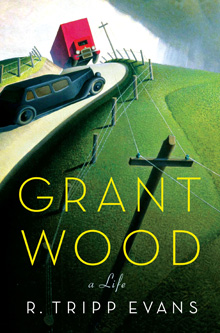Who was Grant Wood? Millions of Americans know him as the artist who painted American Gothic — and that's about it. But since his death, from pancreatic cancer, in 1942, he's become the poster boy for the right and the whipping boy of the left. "Conservative champions," R. Tripp Evans explains in his new biography, "applaud the painter as a folksy chronicler of a bygone America, or a gentle satirist of small-town foibles, whereas his detractors claim (for the very same reasons) that he promoted a cloying, phony, or even sinister form of nationalism. Whether sympathetic or hostile to the artist's work, both camps miss the man who stands before them." Evans himself, however, is on target with a book that could as easily have been titled Grant Wood: A Gay Life.
 |
Not that Wood stood before anyone very visibly. Born in 1891 on a farm 30 miles from Cedar Rapids, he spent his entire life trying to make painting look like a normal, if not macho, occupation for a red-blooded American man. He abjured a painter's smock in favor of overalls; after years of rumors about his extended bachelorhood, he married, in 1935, Sara Sherman Maxon, an older (by seven years) woman whose object was arguably friendship rather than romance. His sexual orientation seems not to have been news to those who knew him, but it could hardly be front-page fare in a world where
Time was hailing Thomas Hart Benton, John Curry, and Grant Wood as exemplars of rugged American individualism and elsewhere homophobic rhetoric ran rampant. Even now, commentary tends to treat his homosexuality as incidental to his work.
Yet Evans makes the case for melding Wood's art with his life, giving particular attention to his authoritarian father (who died when he was 10), his mother, Hattie, to whom he was devoted, his sister, Nan, with whom he had a mutually possessive relationship, and his numerous male friends. The biographer is apt to see male buttocks and penetrating trees in paintings like Stone City, Iowa and Spring Turning where others might not. But there's no doubting Wood's sly subversiveness, or his propensity for misdirection. Is American Gothic really a portrait of a rigid, plain-dealing Midwestern couple? Or could the prominent farm instrument and the in-your-face perspective suggest that this father and daughter (Nan and the artist's dentist were the models) are inviting us to participate in The Iowa Pitchfork Massacre, with optional incest? The Birthplace of Herbert Hoover is not the big house that the miniature figure points to but the tiny cottage next to it. Midnight Ride of Paul Revere would seem to show a miniature Revere riding through some Middlesex town and giving the alarm — only, isn't that Paul's house in North Square at the far right? And doesn't the church he's passing look like Old North? (It looks, stranger still, even more like Old South.) Revere never rode through the North End. Is Wood pulling our historical leg?
You could wish that Evans had devoted more attention to the dream/nightmare aspect of Wood's paintings, or explored the way Wood makes America look like some higher being's Lego set. But this is an observant (right down to the way Evans follows the sansevieria and the begonia of Woman with Plants into the background of American Gothic) and objective (when telling us that Wood felt "a deep attachment to his mother's aprons," he adds, "the strings of which, it must be said, were never cut") study. It's too bad Grant Wood didn't get this kind of fair play when he was alive.
READ: "It's no joke: Grant Wood is truly a great artist," by Jeffrey Gantz